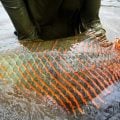Travel Basics: Breaking Down the First Aid Kit, Part 2

Bandaging materials.
In my last post we delved into the importance of a first-aid kit for traveling adventurers, photographers and anglers. Even if you’re not traveling to remote corners of the world, it pays to have the equipment you need close at hand. Sometimes the worst injuries can happen hiking your home trail or fishing familiar rivers with friends.
Part 1 of this series covered the dry bag that houses my kit, basic wound management supplies, QuikClot and the Syringe Suture Medic Kit. Now, let’s take a look at the other items that make up my personal first-aid kit.
• Bandaging: Yesterday we looked at my basic wound-management supplies that live in a smaller packet that always stays on my person. Another ziplock, this one filled with more wound supplies, is part of my overall kit. With gauze, tape, pads and Co-Flex wrap, it’s an easy way to wrap and re-wrap wounds. (I once went through this entire ziplock while treating my own wounds on a shoot… now I pack it a little heavier / fuller). A Leatherman or SOG tool, which is always part of my camera kit, it hand for cutting tape or gauze as needed. It all fits neatly into a little baggie.
• A note on tourniquets: A tourniquet can be an important part of a first-aid kit, but it’s not included in the images for one simple reason: it can be dangerous in the hands of people who do not know how to use it. Do your research, buy a quality one, and learn how to use it. (Note: in a worst-case scenario, a shoelace or similar item can be used as a tourniquet. I always keep several things in my camera case that can be used as a tourniquet as needed.)

Medications for travel.
• Meds: Ah, medications. One of the most important — and ever-evolving — aspects of my medical kit. Over the years I’ve learned what I need (a bomber flu while on assignment in Belize left me bartering Buffs to a boat taxi operator in exchange for a single pack of DayQuil) and what I don’t need. This section will vary person to person, but here’s what works for me:
– Benadryl tabs: Important to keep on hand for possible allergic reactions. I don’t have known allergies, but have seen people react unexpectedly to food or environment and these little tabs live in all my camera bags, tucked away in case of need.
– Imodium: Traveler’s diarrhea happens, and when you’re on the road or in the middle of nowhere, it can be… challenging to manage. When the time comes, you’ll be grateful to have the meds.

Medication baggie.
– Mucinex / DayQuil: Flying long-distance with a flu produced what was hands-down the most painful earache in my life. Not to mention it’s no fun to be sniffling around while trying to get a job done. Do yourself and your traveling companions a favor, and come prepared.
– Katadyn water treatment tabs: I travel with a Graylwater bottle, which is fantastic and cleans water quite well. Even in the middle of nowhere in the Amazon, I didn’t get sick after filtering water with this bad boy. But as a backup, I keep water purification tablets in my kit.
– Ibuprofen: headaches, backaches, body aches, fever… you name it. Good to have around.
– Amoxicillin: These little packets (in French) are from a South Pacific shoot where I came away with infected wounds on my feet, promptly losing both big toenails later on that summer. Luckily a traveling nurse happened to be on the island and could give me these antibiotics to start managing the infection immediately, but often that’s not the case. Traveling with an antibiotic is a very personal choice, and most antibiotics are best at treating rather specific symptoms. Talk with your doctor about their recommendations, pending your personal health and travel destinations.
– Cough drops: Again, pretty self-explanatory. Sure, they take up space, but you’ll be glad to have them when you need them. (This particular roll of Halls Throaties was purchased in Auckland, on the way home from a shoot in Samoa with a full-blown flu. Rarely have I been so willing to pay airport prices for medications!)
– Dramamine Less-Drowsy: I’ve learned the hard way over the years, sometimes I can get seasick. And as I’d rather be focusing my attention on getting the shot rather than not offering up my lunch to Poseidon, less-drowsy Dramamine has been awesome. One tab before a day out on rough seas (or winding, bumpy roads in developing countries) and I can relax, enjoying the trip while not feeling exhausted or sick. Little tabs that have made a big difference in my travel. (And you’ll be a rockstar if there’s someone traveling with you who starts to feel motion sick.)
– Not shown: Nuun tablets. These little electrolyte tabs hardly take up any space and come with me on ever trip. In the evenings, usually when I’m uploading photos into the computer, I’ll down one bottle of plain water, one bottle of water with a Nuun dissolved in it and then another bottle of plain. Keeps electrolyte levels up — you’d be amazed at how much you lose, even in cold weather — and keeps me feeling good. The taste isn’t overly-sweet or chalky, either.
– Also not shown: Activated charcoal. A more recent addition to my kit, activated charcoal can help flush toxins / irritants from your system if you get the stomach gunk. Whether it’s a placebo affect or not, they do seem to help shorten stomach ailments.

Full first-aid kit, hand for scale.
Again, all these meds fit into their own, labeled baggie. Be certain to keep an eye on expiration dates; I just had to replace two medications because they’d expired. If and when you need the meds in the field, you’ll be grateful you made that extra run to the pharmacy.
A note on tourniquets: A tourniquet can be an important part of a first-aid kit, but it’s not included in the images for one simple reason: it can be dangerous in the hands of people who do not know how to use it. Do your research, buy a quality one, and learn how to use it. (Note: in a worst-case scenario, a shoelace or similar item can be used as a tourniquet. I always keep several things in my camera case that can be used as a tourniquet as needed.)
The Kit, Ready to Go: This is what the dry bag looks like with everything inside. As you can see, it’s quiet compact and easily stowed in a corner of a duffel bag, or can be clipped onto a boat, vehicle, etc. The bright color makes it easy to find even by headlamp!
I also keep a current membership with Global Rescue — it brings significant peace of mind knowing that, should something serious happen, I’ll be taken care of. Knock on wood, I haven’t had to be air evacuated yet (and hope to never be) but it’s comforting to know the option is there.
So that wraps up the look at my basic first-aid kit for travelers! It’s about to be tucked into a duffel as I prepare for a project in the Middle East; part of the pre-trip prep that’s become a sort of ritual.
I’d love to hear from all of you — what’s in your first-aid kit that you’d add to this list? What’s been helpful in the field?
See Jess McGlothin’s outdoors photography at https://www.jessmcglothlinmedia.com.











